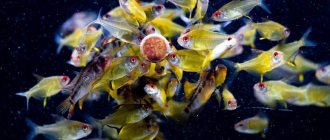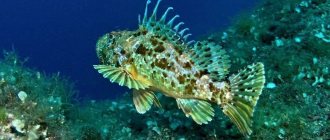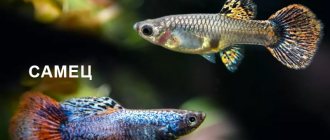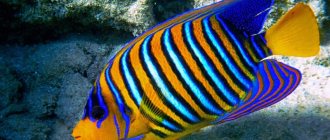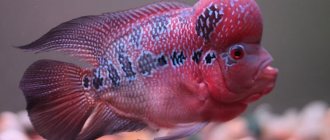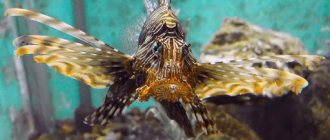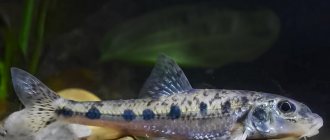The most poisonous fish in the world: Unsplash The most poisonous fish are responsible for dozens of deaths every year. In order not to encounter danger somewhere at a sunny resort, you should know what the deadly inhabitants of the depths look like and how they can harm a person. The top ten dangerous species are puffer fish.
What are the most poisonous fish in the world? Among the most dangerous to humans are the following poisonous fish: pufferfish, wartfish, zebra fish, large dragon, toadfish, scorpionfish, stingray, inimicus, trunk fish and seabird.
Puffer fish
What is the most poisonous fish in the world? The Guinness Book of Records lists the most poisonous fish in the world as fish from the pufferfish family, or dog fish. The caviar, skin and liver of puffer fish (dogfish) contain a dose of tetrodotoxin that is lethal to humans. The fish does not produce the dangerous poison itself, but rather secretes it from its diet and accumulates it. Encyclopedia Britannica lists fish as one of the ten most dangerous fish for humans.
Where does the most poisonous fish in the world live? Puffer fish has a wide range. It can be found in the northwestern regions of the Pacific Ocean, as well as in fresh Asian rivers of the Indo-Pacific basin.
Puffer fish: Wikipedia
Fish are well known not only to biologists and gourmets around the world. The dogfish is used to produce a popular Japanese dish, fugu. Most often it is prepared from the most common and very poisonous type of fish - brown rockfish. To prepare this dangerous delicacy, Japanese chefs have to study for a long time and must obtain a government license.
An error in preparation can lead to painful death from paralysis and suffocation. The paralyzed person remains conscious until death. There is no antidote for tetrodotoxin, although a person can be saved using artificial life support. Every year, about 5 people die because of the dangerous delicacy fugu.
Maintenance and care, arrangement of the aquarium
Taking into account the size of an adult individual and a sedentary lifestyle, an aquarium of 300 liters or more is suitable for keeping. There is no need to recreate the silted beaches characteristic of the natural habitat. In the design you can use gravel with large boulders and other dark soil. The presence of snags and aquatic vegetation is welcome. Plants must be adapted to grow in brackish conditions. The aquarium should contain brackish water with a salt concentration of 5 to 20 grams per 1 liter of water. Fish will not survive long in fresh water. Successful management depends on maintaining stable water conditions. In addition to maintaining the filtration system, regular removal of organic waste and weekly partial water changes of 25 to 50% or more should be ensured. Volumes depend on salinity and number of inhabitants. The specifics of caring for such an aquarium are determined individually, so it is impossible to give precise instructions.
Wart
The warty fish, or stone fish, is a poisonous predator of the scorpionfish family with a body 30–40 cm long. The color from brown to green performs a good camouflage function.
The fish lives in the tropical waters of the Indian and Pacific oceans, from the Red Sea to Australia. It can be found in the shallow waters of the resorts of Hurghada and Sharm el-Sheikh. Residents of Japan and Hong Kong eat wart fillets as food.
Wart: Wikipedia
The stonefish is the deadliest poisonous fish in the world. It poses a great danger to a person who swims in shallow water. Due to its unique specific color, it is very similar to a stone, so it is difficult to notice at the bottom.
At the slightest irritation, it produces strong and sharp spines on its dorsal fin, which can even pierce shoes. The poison injected causes severe pain, shock and paralysis, which can cause a person to die within a few hours if they do not receive medical attention.
How to treat toad poison
The venom from the bite of this fish does not have a proper antidote that can completely eliminate it. Therefore, it is necessary to know more about this poison in order to cure it. Symptoms and damage must be carefully monitored to prevent possible exacerbations.
Next, we are going to describe the steps to take if you are bitten by a toad:
- Try to extract as much venom as possible to make the wound less severe. You need to put pressure on the wound so that it bleeds as much as possible. and the greatest amount of poison is extracted.
- We will apply a tourniquet a few centimeters above the wound and loosen it to allow blood to circulate.
- We use hot water up to about 50 degrees so that the pain subsides . We will do this in an hour and a half.
- If the wound does not bleed, an incision will have to be made so that the bleeding can release more venom. The wound we must inflict must be very small so as not to require surgical closure.
- It is advisable to introduce an amount of 0.1-0.5 ml of 5% potassium permanganate. This will probably need to be done by a specialized doctor.
- To relieve pain from a bite, it is good to administer meperidine hydrochloride intramuscularly.
As always, the best cure for this is prevention. Let's heed the danger signs and limit our bathrooms to the permitted and safest places. I hope this information helps you learn more about frogfish.
Zebra fish
The zebra fish, or striped lionfish, is a species of ray-finned fish of the scorpionfish family. These are predatory fish armed with poisonous spines. The maximum size of lionfish reaches 48.8 cm, on average these fish grow up to 45 cm. Zebra fish live in the tropical regions of the Indian and Pacific oceans. The largest populations are observed off the coasts of Japan, China and Australia.
Zebra fish: Wikipedia
The fish uses dangerous spines for self-defense. When threatened, she turns over and injects with poison. A person who receives such an injection feels severe, sharp pain at the injection site and in the head. The poison causes vomiting and difficulty breathing. Without timely medical care, a person dies.
Zebra fish has very tasty and tender meat. Because of this, it becomes an important fishing target. Today, the lionfish population is not in danger, but the zebra fish itself poses a serious threat to coral reefs and their inhabitants.
Hairy frogfish: Nature's highest level of camouflage
Marine biologists are lazy people and don’t worry about names at all. Swordfish, sawfish, hairy frogfish
...wait, what?
Hairy - yes, okay. Fish - well, let's say. But a frog is the last thing this thing looks like! Let's take a close look at this uh... creature living in the Indian Ocean
and figure out what it is and what it is eaten with.
A hairy tangerine that they forgot to eat since the New Year.
Instead of quickly cutting through the water column, the frog fish lies calmly between the stones
.
Because of such a lazy life, all 40 centimeters of
the fish’s body were covered
with branched hair
.
Moreover, long-term stubble is not scales, but many leathery outgrowths
.
In the human world, such negligence is not welcome (body-positive people have left the chat), but in the underwater world it is a luxurious disguise
.
At first glance, the fish looks like some random trash on the shore.
Okay, but what do frogs have to do with it? First, take a look at its pectoral fins
.
Wide and powerful
- they look like a frog's leg.
With them the fish moves clumsily along the bottom
when it gets tired of lying like a stone.
Secondly, take a closer look at the mouth
.
The wide mouth resembles the bite of an amphibian. Swims and screams.
But how do you get food while being a passive fat something? Well, the frog fish, having heard enough quotes about a man, a fish and a fishing rod, grew a bait on its head
, following the example of deep-sea relatives - anglerfish.
And this move turned out to be very successful! If I didn’t know that this was bait, I would have fallen for the artificial worm myself - it’s too believable!
Short hairy frogfish fishing rod
, but this is only a plus for our heroine.
As soon as the victim falls for the fake worm, the toad's mouth comes into play - with it the shaggy bun simply sucks the careless small fish into itself
. What does the unsuspecting prey see? First a bunch of algae, then a free lunch, and finally a giant mouth that sucks the unfortunate creature in like a black hole.
- Guys, is it just me, or is this stone looking at us strangely?
- No, it doesn’t seem))) There is, however, one subtlety here: not only small fish are interested in bait - there is a high risk of losing its appendage in the mouth of a larger predator
.
Alas, our heroine cannot hunt without her machine
.
But the frogfish does not remain hungry for long - fortunately for it, the homemade fishing rod will grow back in a week or two
, and the hairy frog will again begin to deceive the naive sea inhabitants.
Catch a big fish, but a small one is better.
But little more than nothing is known about the reproduction of frogs. There are definitely males and females, and they definitely give birth - but no one knows how they do it. But it is known that frog fish have no parents
.
All species of this family practice cannibalism in relation to their children
.
Given the lifestyle of the adults, it is ironic that only the fastest young survive.
Your face when you looked at yourself on January 1st.
What does this story teach us? Because you need to always remember two things: firstly, free cheese can only be found in a mousetrap, and secondly, never trust hairy stones.
Big dragon
Another poisonous predatory ray-finned fish of the dragon family is the large dragon. It lives in the coastal waters of the Mediterranean and Black Seas, as well as off the European shores of the Atlantic Ocean. Body length reaches 25–50 cm, weight – up to 2 kg.
The predator fish has poisonous spines. The little dragon likes to burrow into soft ground in anticipation of prey, which makes it difficult to see and you can accidentally step on it. This poses the greatest danger to humans. Fishermen often suffer because they prick themselves on thorns when they unroll a net that catches large dragonets.
Great dragon: Wikipedia
As scientist R. S. Davis says, a stung person feels incredibly severe pain, which in the area of the injection can persist for up to several months. Fatalities are rare and are associated not with fish toxin, but with secondary infections.
Toadfish
The toadfish is a predatory species of the toadfish genus of the batrachidae family. They live in the western regions of the Atlantic Ocean. The body length of the fish is about 40 cm, weight reaches 2 kg. The favorite hunting tactic of these fish is to burrow into the muddy or sandy bottom. Because of this, you can accidentally step on the fish. The fish has poisonous spines on its back, the injection of which is very painful. The fish makes loud beeping sounds, which can be painful to the ear up close.
Toadfish: Wikipedia
Toadfish not only pose a danger to humans, but sometimes served him for scientific purposes. In 1998, NASA launched several toadfish into space on the space shuttles Columbia and Discovery and observed the behavior of marine inhabitants in zero gravity.
Reproduction
The spawning season for these fish begins in June – July. One female toadfish lays up to 500 eggs, which the male then guards for about three weeks.
Toadfish fry closely resemble tadpoles. This is another of the many similarities between fish and amphibians. Toad fish become sexually mature when they reach two years of age.
Toadfish often become inhabitants of aquariums.
Scorpena
The Black Sea scorpionfish is a predatory fish of the scorpionfish family, to which it gave its name. It lives in the Black and Mediterranean Seas, the eastern part of the Atlantic Ocean, and is sometimes found in the Sea of Azov. Spends most of its time in the thickets on a rocky bottom, waiting for prey.
Scorpena: Wikipedia
The scorpionfish has very tasty meat, but it is dangerous for scuba divers, fishermen and cooks because its bone spines and spines contain poison. The poisonous fish mucus that gets into the wound causes severe inflammation.
Nutrition
Relying on its camouflage, the three-spined toadfish can remain motionless for a long time, waiting for prey to swim nearby. If the victim is too close, a lightning-fast reaction will follow and it will be swallowed. In the wild, the diet is very varied and consists of fish, crabs, shrimp, octopus, bivalves, snails, sea urchins and polychaetes. The home aquarium will accept bloodworms, earthworms, fish meat (for example, regular pollock from the store) and shrimp. The frequency of meals is 1–2 times a week, which is quite sufficient and corresponds to the diet in nature.
stingray
The stingray is a representative of the family of cartilaginous fish of the order Stingrays of the superorder of stingrays. These stingrays live in all tropical and subtropical seas. They lead a bottom-dwelling lifestyle and are found in coastal areas, mangroves and brackish estuaries. They have a flat body and a long poisonous tail.
Stingray: Wikipedia
According to legend, Odysseus died from a spear with a stingray. It was because of an attack by a stingray and a stab in the heart that the famous naturalist Steve Irwin died.
Inimicus
Inimicus are poisonous ray-finned fish of the scorpionfish family. They reach a length of 25 cm. The body is partially covered with scales. Inimicus are predators that burrow into the sand to hunt. This is how they ambush worms and crustaceans. According to National Geographic, people often step on camouflaged fish, which pose a deadly threat. Near its dorsal fin there are spines with a neurotoxin.
Inimicus: Wikipedia
Katran shark
Katrans do not fit the stereotypes about sharks. This small fish (about a meter long) will never attack a person first. Small sharks live throughout almost the entire oceanic space of the planet. But are they so harmless, and why are they on this list then? Since a person himself is always looking for a meeting with katrans (commercial fish), he takes a conscious risk. The mini shark has spines on its dorsal fins, with venom glands hidden in the back. Most wounds occur when removing the catch from the net - the fisherman receives a severe burn, accompanied by prolonged pain. Katran's poison is not lethal, but the wound will ache for several days.
Trunk fish
The bodyfish class of ray-finned fish is a family of toxic fish. Due to the characteristic shape of their “beak” they are called trunk fish. The body length of different species varies from 11 to 55 cm. The body is protected by a shell made of hexagonal-shaped bone plates. The skin is bare and covered with mucus. Bodyfish live in tropical regions of the Pacific, Indian and Atlantic oceans. They can be found in tourist areas of the Red Sea and off the coast of Australia.
Trunk fish: Wikipedia
Fish are capable of producing a special neurotoxin - pachutoxin. It spreads through the skin and mucus of the animal, quickly dissolves in water and poisons surrounding fish. Since the poison is contained in the tissues of fish meat, it is dangerous to eat. Proper processing neutralizes toxins and makes fish meat edible. Fish occupies an important place in the local fishery.
sea lady
Another representative of the dangerous poisonous fish of the dragon-like order is seaweeds, or stargazers. The family includes about 50 species of fish, all of which are poisonous. Predators live in the seas and estuaries in the warm zones of the Atlantic, Indian and Pacific oceans. The predator is predominantly nocturnal, and during the day it burrows into bottom silt or sand.
Seabird: Wikipedia
The maximum body length is 90 cm. Some species rarely exceed 22 cm in length, for example the European stargazer. The scales of the fish are small or almost absent. It is not eaten, so the venom of the sea cow is dangerous only for swimmers. Stargazers have poisonous spines on their bodies, which are connected to poisonous glands. In addition, fish have electrical organs and are capable of creating a discharge that is not dangerous to humans.
The most poisonous fish in the world can injure and even kill people. When you go on vacation to warm countries or order an exotic dish in a restaurant in a foreign country, avoid the most dangerous poisonous fish on the planet.
Original article: https://www.nur.kz/leisure/interesting-facts/1116506-smertelno-vkusno-fugu-samaya-yadovita/
Striped lionfish
Striped lionfish
This is a very cute thirty-centimeter fish, but at the same time dangerous. On its beautiful fins with fluttering colorful ribbons there are sharp needles containing poison. One injection and paralysis of the skeletal and respiratory muscles is ensured. Therefore, the victim must be immediately pulled ashore, otherwise he will drown. Lionfish do not attack first. Either divers accidentally touch a fish hidden in the corals, or they want to stroke such a beauty - and this is the result. The lionfish is a dangerous predator that uses different tactics when hunting. If there is a secluded place nearby, the striped lionfish drives prey there with its long poisonous fins and quickly eats it. Or the lionfish freezes motionless among the corals, becoming like an outlandish sea plant. A stupid little fish, suspecting nothing, swims close to an exotic “flower”, which suddenly comes to life and swallows it.
